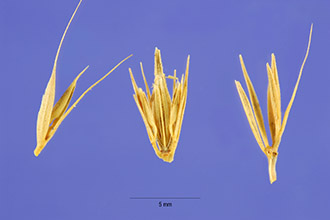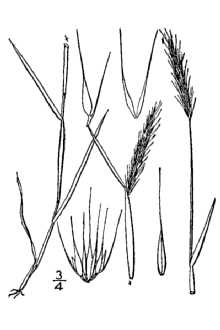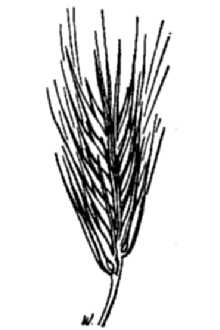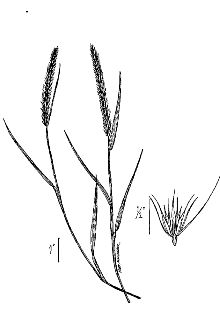Hordeum pusillum Nutt. var. pubens Hitchc.
Scientific Name: Hordeum pusillum Nutt. var. pubens Hitchc.
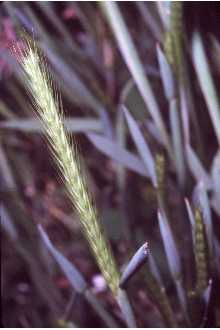
| General Information | |
|---|---|
| Usda Symbol | HOPUP |
| Group | Monocot |
| Life Cycle | Annual |
| Growth Habits | Graminoid |
| Native Locations | HOPUP |
Plant Guide
Description
General: Little barley is a tufted annual grass with culms generally 10-60 cm tall (Gould, 1975). Blades 3.5-12 cm long and 2-3.5 mm wide lanceolate, flat, glabrous or pubescence (Everitt et al., 2011). Spikelets 3 per node, 1 sessile and fertile, 2 lateral spikelets pedicellate and sterile (Hatch and Pluhar, 1993). Disarticulating seed segments adhere tight to clothing. There are approximately 193,000 seeds per pound. Chromosome number 2n=14 (Gould, 1975). Distribution: Little barley is widespread across much of the United States and southern Canada (Barkworth et al., 2007). For current distribution, please consult the Plant Profile page for this species on the PLANTS website. Habitat: Little barley is common in open grasslands, pastures, roadsides, and waste areas. It is generally associated with disturbance and is often found in alkaline soils (Barkworth et al., 2017).
Adaptation
Little barley is adapted to a wide variety of soils, is often considered a weedy species, and one of the first species to green up in the spring. It is common in overgrazed pastures, along roadsides, and other disturbed sites (Shaw, 2012).
Uses
Because little barley is an early colonizing species on disturbed areas, it is an excellent candidate for including in right-of- way seedings for temporary soil erosion control. Little barley also has the potential as a native cool season cover crop replacing other cereal grains currently used for temporary cover. It is considered poor forage for livestock, but the florets are eaten by wild turkeys (Everitt et al., 2011).
Status
Weedy or Invasive: This plant may become weedy or invasive in some regions or habitats and may displace desirable vegetation if not properly managed. Since little barley is an annual species, additional care should be taken when making management decisions to limit the species ability to become problematic. Please consult with your local NRCS Field Office, Cooperative Extension Service office, state natural resource, or state agriculture department regarding its status and use. Please consult the PLANTS website (http://plants.usda.gov/) and your state’s Department of Natural Resources for this plant’s current status (e.g., threatened, or endangered species, state noxious status, and wetland indicator values).
Planting Guidelines
Begin seedbed preparation in advance of planting by either tillage or herbicides. The site should be firm and have accumulated soil moisture prior to planting. Plant seed with a drill or broadcast seeder. If broadcast seeded, some type of additional coverage such as culti-packing or light dragging is recommended to cover the seed and ensure good seed-to-soil contact. Plant seed ⅛ to ¼-inch deep. It is better to plant too shallow than too deep. For calibration purposes, little barley contains approximately 193,000 seeds per bulk pound. Recommended seeding rate is 5 pounds pure live seed (PLS) per acre for solid stands. Adjust the seeding rate when used in a mix with other species. Natural Resources Conservation Service Plant Guide
Management
Defer grazing for 90 days to allow plants to establish. Allow established plants to produce seed annually because little barley readily reseeds itself with minimal soil disturbance.
Pests and Potential Problems
There are no potential problems or pests associated with little barley.
Environmental Concerns
Concerns
Concerns
There are no environmental concerns associated with little barley.
Control
Please contact your local agricultural extension specialist or county weed specialist to learn what works best in your area and how to use it safely, Always read label and safety instructions for each control method, Use soil moisture sensors to measure the soil moisture of Hordeum pusillum Nutt. var. pubens Hitchc.., Trade names and control measures appear in this document only to provide specific information, USDA NRCS does not guarantee or warranty the products and control methods named, and other products may be equally effective,
Seeds and Plant Production
Plant Production
Plant Production
Seed production fields are best started from greenhouse grown transplants, planted on bedded rows. Seedlings grow and mature quickly and will produce a marketable crop in the year of planting. Seed harvest is possible using a variety of methods and implements. Seed ripens indeterminately, and a Flail Vac harvester collects the ripe seed crop without damaging or eliminating the ability to make subsequent harvests of the stand as later flowering florets mature. Little barley seed typically matures early in the spring with harvests occurring as early as April. Potential seed yields per acre is estimated at 250 PLS lbs per acre when planted on 36-inch bedded rows with a plant population of 14,000 plants per acre. Cultivars, Improved, and Selected Materials (and area of origin) Choose cultivars and other selected materials based on the local climate, resistance to local pests, and intended use. Consult with your local land grant university, local extension or local USDA NRCS office for recommendations on adapted sources for use in your area. Cibolo Germplasm little barley was collaboratively released in 2021 by Texas Native Seeds, USDA-NRCS James E. “Bud” Smith Plant Material Center in Knox City, TX, Sul Ross State University, Alpine, TX, and Texas Agrilife Research Center, Stephenville, TX. It consists of three collections from the Rio Grande Plains (MLRA 083A-D) and Edwards Plateau (MLRA 081A-D) ecoregions. Cibolo Germplasm is recommended for use as a cool season cover crop, critical site revegetation, inclusion in range seeding mixes, and rights-of-way plantings in west, south, and central Texas.
Literature Cited
Barkworth, M.E., L.K. Anderton, K.M. Capels, S. Long, and M.B. Piep. 2007. Manual of Grasses for North America. Utah State University Press. Logan, Utah. Everitt, H.J., D.L. Drawe, C.R. Little, and R.I. Lonard. 2011. Grasses of South Texas. Texas Tech University Press. Lubbock, Texas. Gould, F.W. 1975. The Grasses of Texas. Texas A&M University Press. College Station, Texas. Hatch, L.H. and J. Pluhar. 1993. Texas Range Plants. Texas A&M University Press. College Station, Texas. Shaw, R.B. 2012. Guide to Texas Grasses. Texas A&M university Press. College Station, TX. Citation Falk, A. and C.B. Carr. 2021. Plant Guide for little barley (Hordeum pusillum). USDA-Natural Resources
Conservation
Service, James E. “Bud” Smith Plant Materials Center, Knox City, Texas. Published February 2021. For more information about this and other plants, please contact your local NRCS field office or Conservation District at http://www.nrcs.usda.gov/ and visit the PLANTS website at http://plants.usda.gov/ or the Plant Materials Program website: http://plant-materials.nrcs.usda.gov. PLANTS is not responsible for the content or availability of other websites.
Plant Traits
Growth Requirements
| Temperature, Minimum (°F) | 32 |
|---|---|
| Adapted to Coarse Textured Soils | No |
| Adapted to Fine Textured Soils | Yes |
| Adapted to Medium Textured Soils | Yes |
| Anaerobic Tolerance | Medium |
| CaCO3 Tolerance | Medium |
| Cold Stratification Required | No |
| Drought Tolerance | Low |
| Fertility Requirement | Low |
| Fire Tolerance | None |
| Frost Free Days, Minimum | 80 |
| Hedge Tolerance | None |
| Moisture Use | Medium |
| pH, Maximum | 8.0 |
| pH, Minimum | 6.2 |
| Precipitation, Maximum | 60 |
| Precipitation, Minimum | 10 |
| Root Depth, Minimum (inches) | 8 |
| Salinity Tolerance | Medium |
| Shade Tolerance | Intolerant |
Morphology/Physiology
| Bloat | None |
|---|---|
| Toxicity | None |
| Resprout Ability | No |
| Shape and Orientation | Erect |
| Active Growth Period | Spring |
| C:N Ratio | Low |
| Coppice Potential | No |
| Fall Conspicuous | No |
| Fire Resistant | No |
| Flower Color | Yellow |
| Flower Conspicuous | No |
| Foliage Color | Green |
| Foliage Porosity Summer | Moderate |
| Foliage Porosity Winter | Porous |
| Fruit/Seed Color | Brown |
| Fruit/Seed Conspicuous | No |
| Growth Form | Bunch |
| Growth Rate | Rapid |
| Height, Mature (feet) | 1.2 |
| Known Allelopath | No |
| Leaf Retention | No |
| Low Growing Grass | No |
| Nitrogen Fixation | None |
| Foliage Texture | Medium |
Reproduction
| Propagated by Seed | Yes |
|---|---|
| Propagated by Sod | No |
| Propagated by Sprigs | No |
| Propagated by Tubers | No |
| Fruit/Seed Persistence | No |
| Seed per Pound | 30000 |
| Seed Spread Rate | Moderate |
| Seedling Vigor | High |
| Small Grain | No |
| Vegetative Spread Rate | None |
| Propagated by Corm | No |
| Propagated by Container | No |
| Propagated by Bulb | No |
| Propagated by Bare Root | No |
| Fruit/Seed Period End | Summer |
| Fruit/Seed Period Begin | Spring |
| Fruit/Seed Abundance | Medium |
| Commercial Availability | No Known Source |
| Bloom Period | Late Spring |
| Propagated by Cuttings | No |
Suitability/Use
| Veneer Product | No |
|---|---|
| Pulpwood Product | No |
| Protein Potential | Low |
| Post Product | No |
| Palatable Human | No |
| Palatable Graze Animal | Low |
| Palatable Browse Animal | Low |
| Nursery Stock Product | No |
| Naval Store Product | No |
| Lumber Product | No |
| Fodder Product | No |
| Christmas Tree Product | No |
| Berry/Nut/Seed Product | No |

